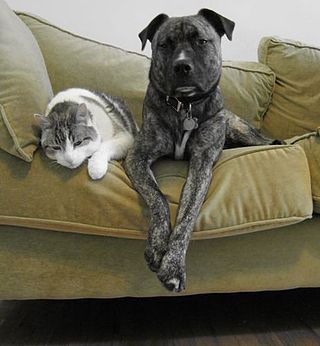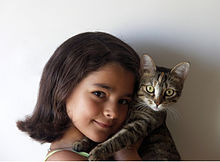
A pet, or companion animal, is an animal kept primarily for a person's company or entertainment rather than as a working animal, livestock, or a laboratory animal. Popular pets are often considered to have attractive/cute appearances, intelligence, and relatable personalities, but some pets may be taken in on an altruistic basis and accepted by the owner regardless of these characteristics.

Dehumanization is the denial of full humanity in others along with the cruelty and suffering that accompany it. A practical definition refers to it as the viewing and the treatment of other people as though they lack the mental capacities that are commonly attributed to human beings. In this definition, every act or thought that regards a person as "less than" human is dehumanization.

A companion dog is a dog which is not primarily a working dog but a pet. The primary function of a companion dog is not to perform a useful job but to provide companionship to humans. A companion dog can also be called an emotional support animal and is used to help people with mental health disabilities cope with symptoms. Most dogs can be companions, including many working dog breeds such as retrievers, who are enjoyed primarily for their friendly nature as a pet. Most toy dog breeds are used only for the pleasure of their company, not as workers. The American Kennel Club also offers a Companion dog title for judged dog obedience competitions.
Robotic pets are artificially intelligent machines that are made to resemble actual pets. While the first robotic pets produced in the late 1990s were not too advanced, they have since grown technologically. Many now use machine learning, making them much more realistic. Most consumers buy robotic pets with the aim of getting similar companionship that real pets offer, without some of the drawbacks that come with caring for live animals. The pets on the market currently have a wide price range, from the low hundreds into the several thousands of dollars. Multiple studies have been done to show that we treat robotic pets in a similar way as actual pets, despite their obvious differences. However, there is some controversy regarding how ethical using robotic pets is, and whether or not they should be widely adopted in elderly care.

Anthrozoology, also known as human–nonhuman-animal studies (HAS), is the subset of ethnobiology that deals with interactions between humans and other animals. It is an interdisciplinary field that overlaps with other disciplines including anthropology, ethnology, medicine, psychology, social work, veterinary medicine, and zoology. A major focus of anthrozoologic research is the quantifying of the positive effects of human–animal relationships on either party and the study of their interactions. It includes scholars from fields such as anthropology, sociology, biology, history and philosophy.
Pet insurance is a form of insurance that pays, partly or in total, for veterinary treatment of the insured person's ill or injured pet. Some policies will pay out when the pet dies, or if the pet is lost or stolen.

Pet food is animal feed intended for consumption by pets. Typically sold in pet stores and supermarkets, it is usually specific to the type of animal, such as dog food or cat food. Most meat used for animals is a byproduct of the human food industry, and is not regarded as "human grade".
An emotional support animal (ESA) is an animal that provides relief to individuals with "psychiatric disability through companionship." Emotional support animals are not required to be trained. Any animal that provides support, comfort, or aid, to an individual through companionship, unconditional positive regard, and affection may be regarded as an emotional support animal.

Anthropomorphism is the attribution of human traits, emotions, or intentions to non-human entities. It is considered to be an innate tendency of human psychology. Personification is the related attribution of human form and characteristics to abstract concepts such as nations, emotions, and natural forces, such as seasons and weather. Both have ancient roots as storytelling and artistic devices, and most cultures have traditional fables with anthropomorphized animals as characters. People have also routinely attributed human emotions and behavioral traits to wild as well as domesticated animals.
The National Animal Interest Alliance (NAIA) is a non-profit organization in the United States dedicated to promoting animal welfare and animal husbandry practices, strengthening the human-animal bond, and safeguarding the rights of responsible animal owners and professionals through research, public education and public policy. The NAIA mission is "to promote the welfare of animals."

Human–canine bonding is the relationship between dogs and humans. This relationship can be traced back to at least 15,000 years ago, to the Bonn-Oberkassel dog, who was found buried alongside two humans. For centuries, dogs have been considered man's best friend. This is most evident in western countries, such as the United States, where over 48% of households have a pet dog.

Human interaction with cats relates to the hundreds of millions of cats that are kept as pets around the world. The inter-relationship involves companionship, communication and caregiving. Dating back thousands of years, cats were originally domesticated for their ability to control pests and later became valued companions. Cats communicate through vocalizations, body language and behaviors, forming strong bonds with their human owners. Owners provide the food, shelter, and medical care, while play and enrichment activities stimulate their physical and mental well-being. Despite their independent nature, cats enjoy human company and require understanding of their unique behaviours. Positive reinforcement training can shape desired behaviours, fostering a harmonious relationship between humans and their feline companions, built on mutual respect and affection.

An interspecies friendship is a nonsexual bond that is formed between animals of different species. Numerous cases of interspecies friendships among wild and domesticated animals have been reported and documented with photography and video. Domestication of animals has led to interspecies friendships between species that would never naturally exist together. In many cases of interspecies friendship, the species are not normally seen together, and sometimes, one is of a species that ordinarily preys on the other in nature.

Pauleen Charmayne Bennett is an Australian scientist researching anthrozoology at La Trobe University in Victoria, Australia.

Dog fashion is a popular style or practice, especially in canine clothing and accessories. Dog fashion is a distinctive trend of the style in which people dress their canine companions. This trend dates back to the Egyptian predynastic period and has since expanded due to increased consumer capitalism. Other animals such as cats may also wear fashion.
Between 5% and 10% of homeless peoplein the United States own pets. Studies of homeless pet owners in urban settings show a sense of identity and community connection between pets and their owners. This topic is part of the Animals and Society branch of study in the field of Sociology, and is also an issue with the values and responsibility of pet ownership.
James A. Serpell is professor of Animal Ethics and Welfare at the University of Pennsylvania. He lectures in the School of Veterinary Medicine on veterinary ethics, applied animal behavior and welfare, and human-animal interactions. Serpell also directs the Center for the Interaction of Animals and Society (CIAS). Serpell was a founder of The International Society for Anthrozoology(ISAZ) and remains on the board.
The pet industry is the market industry associated with companion animals. It includes things that are associated with the production, consumption and cultural activities linked to the market. Next to nutrition, toys and animal healthcare, new services and products like taxis, kindergartens, hotels, IT appliances, broadcasting, theme parks and funeral services are appearing on the market.
Pet culture refers to the culture revolving around the interaction of humans and pets.

Dog meat consumption can be found in Vietnam, similar to other Asian countries such as South Korea, Laos, and China.
















